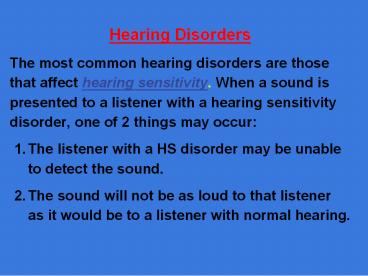Hearing Disorders PowerPoint PPT Presentation
Title: Hearing Disorders
1
- Hearing Disorders
- The most common hearing disorders are those that
affect hearing sensitivity. When a sound is
presented to a listener with a hearing
sensitivity disorder, one of 2 things may occur - The listener with a HS disorder may be unable to
detect the sound. - The sound will not be as loud to that listener as
it would be to a listener with normal hearing.
2
Note Vision is different. The most common vision
disorders affect acuity, not sensitivity to
light. Acuity is the ability to resolve
differences amplifying it but do not improve
acuity. Important This sensitivity vs. acuity
distinction is not quite so simple with hearing
(or vision) hearing loss of any significance
nearly always involves problems of both
sensitivity and acuity sounds are harder to
hear (sensitivity) and they are nearly always
distorted (acuity). More about this later.
3
The Audiogram Most common way to measure hearing
sensitivity is to measure pure-tone (sinusoid)
thresholds. Threshold Sound level required to
barely detect a sound.
4
Mild high-frequency loss
5
Moderate-to-severe bilateral loss
Severe loss in left ear, moderate loss in right
ear.
Pure Tone Average (PTA) Average thresholds at
500, 1000, 2000 Hz the frequencies most
important for speech understanding. From the
audiogram above Pure-tone Average, Left Ear
93 dB Pure-tone Average, Right Ear 50 dB
6
Terminology Normal Hearing PTAs lt 25 dB Hearing
Impairment PTAs 25-92 dB Deaf PTAs gt 92
dB The term deafness is reserved for cases in
which the handicap for hearing everyday
speech is total (Davis Silverman, 1979).
Despite these conventions (1) there is no sharp
dividing line between hearing impairment and
deafness, and (2) degrees of deafness are
meaningful e.g., there is a difference between
PTAs of 110 and 95.
7
- Types of Hearing Disorders
- Many ways to classify hearing disorders
- 1. Nature of the loss
- Sensitivity vs. Acuity
- Dysacusia Deficit in discrimination or
interpretation of sound Dont shout, I can hear
you just fine. I just cant understand what
youre saying. Disacusia is a good term that
isnt in very common use. - Acuity deficits sometimes due to disorders of the
central auditory system. - Disorders of sensitivity and acuity are not
mutually exclusive.
8
- 2. Functional Classification
- Conductive Disorders involving the conduction
of sound to the cochlea. - Sensori-neural Disorders involving the cochlea
(usually the hair cells) or 8th N. - Central Disorders affecting the CNS (brain
stem or auditory cortex). - Two related terms
- Peripheral Not central i.e., conductive or
sensorineural. - Retrocochlear Disorders involving anatomical
structures beyond the cochlea i.e., 8th N, brain
stem, auditory cortex.
9
- 3. Cause or Etiology of the Disorder
- Hearing disorders can be classified on the basis
of the cause of the disorder. Some examples - Ototoxic drugs
- Noise exposure
- Old age (presbycusis)
- Otitis media
- 8th N tumors
- Menieres Disease
- In this review, we will proceed by functional
subsystem (conductive, sensorineural, central),
and by etiology within each subsystem.
10
- Conductive Hearing Disorders
- External Ear
- Congenital malformations. There are many of
these. Most serious is congenital atresia
collapse or closure of the EAM (ear canal). May
occur in isolation, but typically associated
congenital malformations of the middle ear as
well. - Impacted wax (cerumen) results in mild hearing
loss easily treated by removal of the wax.
11
- 2. Middle Ear
- a. Otitis Media
- By far the most common cause of conductive
hearing loss. - By far the most common health problem in
children. - THANK YOU
Contacts Us-
Toll Free- 1800-121-4408
Mail-info_at_hearingsol.com

